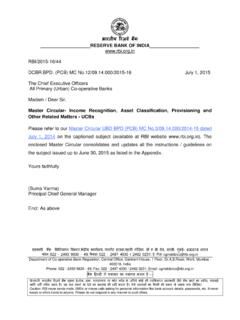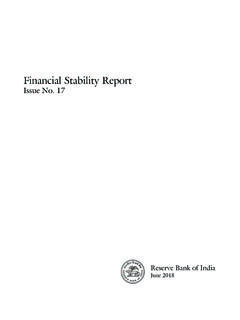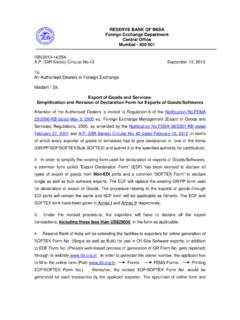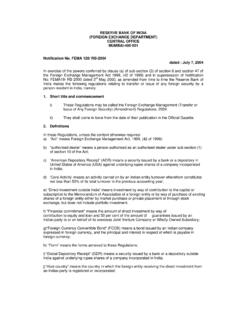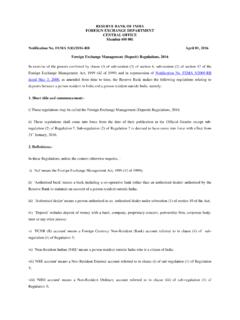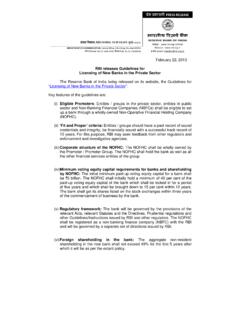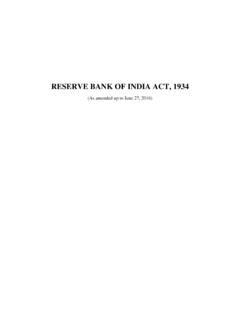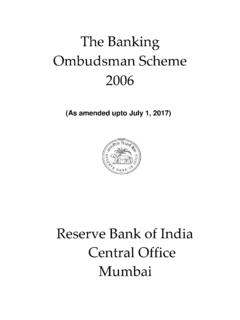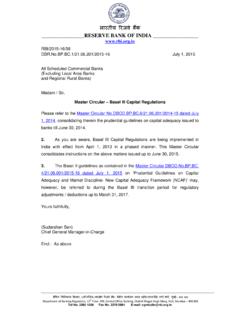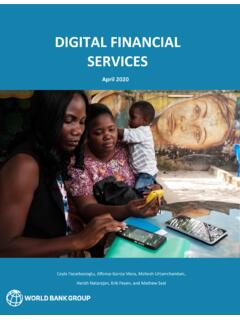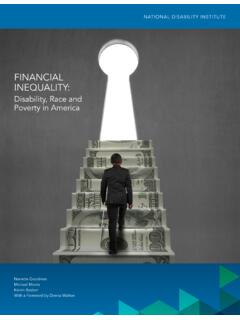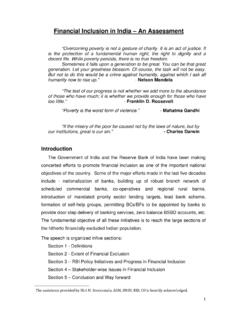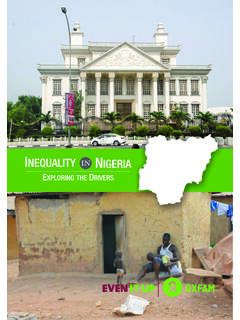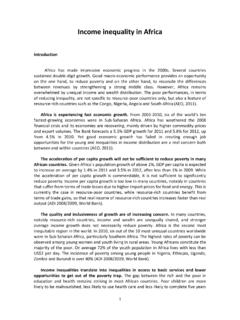Transcription of NatioNal Strategy for fiNaNcial iNcluSioN - Reserve Bank …
1 NatioNal Strategy for fiNaNcial iNcluSioN `The NatioNal Strategy for fiNaNcial iNcluSioN 2019-2024 sets forth the vision and key objectives of the fiNaNcial iNcluSioN policies in India to help expand and sustain the fiNaNcial iNcluSioN process at the NatioNal level through a broad convergence of action involving all the stakeholders in the fiNaNcial sector. The Strategy aims to provide access to formal fiNaNcial services in an affordable manner, broadening & deepening fiNaNcial iNcluSioN and promoting fiNaNcial literacy & consumer Strategy for fiNaNcial Inclusion2019-2024An approach paper to accelerate fiNaNcial iNcluSioN to promote economic wellbeing, prosperity and sustainable developmentTo make fiNaNcial services available, accessible.
2 And affordable to all the citizens in a safe and transparent manner to support inclusive and resilient multi-stakeholder led growthUniversal Access to fiNaNcial ServicesProviding Basic Bouquet of fiNaNcial ServicesAccess to Livelihood and Skill DevelopmentFinancial Literacy and EducationCustomer ProtectionandGrievance RedressalEffective Co-ordinationVisionCONTENTSA bbreviations Chapters I. Introduction 01 II. Cross Country Analysis and Lessons 04 III. Status of fiNaNcial iNcluSioN in India 08 IV. Strategic Objectives 17 V. Recommendations 24 VI. Measurement of Progress of fiNaNcial iNcluSioN 26 VII. Conclusion 33 Bibliography 36 APBS Aadhaar Payment Bridge SystemAEPS Aadhaar Enabled Payment SystemAFI Alliance for fiNaNcial InclusionANBC Adjusted Net Bank CreditATM Automated Teller MachineAPY Atal Pension YojanaBC Business CorrespondentBLBC Block Level Bankers CommitteeBSBDA Basic Savings Bank Deposit AccountCBSE Central Board of Secondary Education CBK Central Bank of Kenya CCC Certified Credit CounsellorsCDD Customer Due DiligenceCFL Centre for fiNaNcial LiteracyCGAP Consultative Group to Assist the PoorCKYC Registry Central Know Your
3 Customer RegistryCMPFI Committee on Medium Term Path on fiNaNcial InclusionCONAIF NatioNal Council for fiNaNcial iNcluSioN CSC Common Service Centre CTS Cheque Truncation SystemDAY Deendayal Antyodaya YojanaDAY-NULM Deendayal Antyodaya Yojana- NatioNal Urban Livelihood MissionDBT Direct Benefit TransferDCC District Consultative CommitteeDCCB District Central Co-operative BankDDU-GKY Pt. Deen Dayal Upadhyaya Grameen Kaushalya YojanaDFS Department of fiNaNcial ServicesDLRC District Level Review CommitteeFAME fiNaNcial Awareness MessageFLC fiNaNcial Literacy CentreFIAC fiNaNcial iNcluSioN Advisory Committee FIF fiNaNcial iNcluSioN FundFIP fiNaNcial iNcluSioN PlanFSDC fiNaNcial Stability and Development CouncilGCC General Credit CardGPFI Global Partnership for fiNaNcial InclusionG2P Government to Person IBA Indian Banks AssociationIFI Index of fiNaNcial InclusionIIBF Indian Institute of Banking and FinanceIMF International Monetary Fund / Insurance Marketing FirmsIMPS Immediate Payment ServiceINFE International Network for fiNaNcial
4 EducationIPPB India Post Payments BankISP Insurance Service Provider IR Insurance RepositoryIGNOAPS Indira Gandhi NatioNal Old Age Pension Scheme ICT Information and Communication TechnologyIRDAI Insurance Regulatory and Development Authority of IndiaJAM Jan Dhan- Aadhaar-MobileKYC Know Your CustomerLDO Lead District Officer LWE Left Wing ExtremistsMIS Management Information SystemMGNREGA Mahatma Gandhi NatioNal Rural Employment Guarantee ActMoF Ministry of FinanceMSME Micro, Small and Medium EnterprisesList of Select AbbreviationsNACH NatioNal Automated Clearing HouseNAMCABS NatioNal Mission for Capacity Building of Bankers for Financing MSME SectorNABARD NatioNal Bank for Agriculture and Rural DevelopmentNEFT NatioNal Electronic Fund TransferNER North Eastern RegionNCFE NatioNal Centre for fiNaNcial EducationNFIS NatioNal fiNaNcial iNcluSioN StrategyNPCI NatioNal Payments Corporation of IndiaNGO Non-Government OrganisationNPS NatioNal Pension SystemNRLM NatioNal Rural Livelihoods MissionNSFI NatioNal Strategy for fiNaNcial InclusionNULM NatioNal Urban Livelihoods MissionNWR Negotiable Warehouse ReceiptsOECD Organisation for
5 Economic Co-operation and DevelopmentPACS Primary Agricultural Co-operative SocietyP2B Person to BusinessP2P Person to Person/ Peer to PeerP2G Person to GovernmentPCR Public Credit Registry PMEGP Pradhan Mantri Employment Guarantee ProgrammePMKVY Pradhan Mantri Kaushal Vikas YojanaPMJDY Pradhan Mantri Jan Dhan YojanaPPF Public Provident FundPB Payments BankPMJJBY Pradhan Mantri Jeevan Jyoti Bima YojanaPMMY Pradhan Mantri Mudra YojanaPMSBY Pradhan Mantri Suraksha Bima YojanaPFRDA Pension Fund Regulatory and Development AuthorityPSGIC Public Sector General Insurance CompaniesRoC Registrar of Companies RTGS Real Time Gross SettlementRXIL Receivables Exchange of India RBI Reserve Bank of IndiaSC Scheduled CasteST Scheduled TribeSEBI Securities and Exchange Board of IndiaSFB Small Finance BanksSIDBI Small Industries Development Bank of IndiaSLBC State Level Bankers CommitteeSME Small and Medium EnterprisesSPV Special Purpose VehicleSRLM State Rural Livelihoods MissionTGFIFL Technical Group on fiNaNcial iNcluSioN and fiNaNcial LiteracyTReDS Trade Receivables Discounting SystemUFA Universal fiNaNcial AccessUIDAI Unique Identification Authority of IndiaUNSDG United Nations Sustainable Development GoalsUPI Unified Payments InterfaceUSSD Unstructured Supplementary Service Data WDRA Warehousing Development and Regulatory
6 AuthorityNatioNal Strategy for fiNaNcial iNcluSioNIntroduction 1I Introduction fiNaNcial iNcluSioN is increasingly being recognized as a key driver of economic growth and poverty alleviation the world over. Access to formal finance can boost job creation, reduce vulnerability to economic shocks and increase investments in human capital. Without adequate access to formal fiNaNcial services, individuals and firms need to rely on their own limited resources or rely on costly informal sources of finance to meet their fiNaNcial needs and pursue growth opportunities.
7 At a macro level, greater fiNaNcial iNcluSioN can support sustainable and inclusive socio-economic growth for There has been a growing evidence on how fiNaNcial iNcluSioN has a multiplier effect in boosting overall economic output, reducing poverty and income inequality at the NatioNal level. fiNaNcial iNcluSioN of women is particularly important for gender equality and women s economic empowerment. With greater control over their fiNaNcial lives, women can help themselves and their families to come out of poverty ; reduce their risk of falling into poverty ; eliminate their exploitation from the informal sector; and increase their ability to fully engage in measurable and productive economic activities.
8 An inclusive fiNaNcial system supports stability, integrity and equitable growth. Therefore, fiNaNcial exclusion because of several barriers like physical, socio-cultural and psychological, warrants attention from the policy makers. Some of the key reasons resulting in involuntary exclusion are: Lack of surplus incomeLack of trust in the systemNot suitable to customer s requirementsHigh transaction costsLack of requisite documentsRemoteness of service providerLack of awareness about the productPoor quality of services rendered Figure - Causes of fiNaNcial Exclusion2 NatioNal Strategy for fiNaNcial iNcluSioN 2019-2024 fiNaNcial iNcluSioN and United Nations Sustainable Development Goals It is also noteworthy to state that, seven1 of the seventeen United Nations Sustainable Development Goals (SDG)
9 Of 2030 view fiNaNcial iNcluSioN as a key enabler for achieving sustainable development worldwide by improving the quality of lives of poor and marginalized sections of the society. (Home- Sustainable Development Goals, 2018)Defining fiNaNcial iNcluSioN in the Indian fiNaNcial iNcluSioN has been defined as the process of ensuring access to fiNaNcial services, timely and adequate credit for vulnerable groups such as weaker sections and low- income groups at an affordable cost . (Committee on fiNaNcial iNcluSioN - Chairman: Dr C Rangarajan, RBI, 2008). The Committee on Medium-Term Path to fiNaNcial iNcluSioN (Chairman: Shri Deepak Mohanty, RBI, 2015) has set the vision for fiNaNcial iNcluSioN as, convenient access to a basket of basic formal fiNaNcial products and services that should include savings, remittance, credit, government-supported insurance and pension products to small and marginal farmers and low- income households at reasonable cost with adequate protection progressively supplemented by social cash transfers, besides increasing the access of small and marginal enterprises to formal finance with a greater reliance on technology to cut costs and improve service delivery.
10 fiNaNcial iNcluSioN Strategy - While a lot of efforts have been undertaken to increase fiNaNcial iNcluSioN in the country (See Chapter III- Status of fiNaNcial iNcluSioN in India) a lot of steps are further needed to ensure adequate access to fiNaNcial services and usage of these services by various segments of under-served and un-served population in India, so far. Anchored in the country s development priorities, the NSFI 2019-2024 seeks to address the inherent barriers of access to a gamut of fiNaNcial products and services. An inclusive fiNaNcial system (ably supported through sound fiNaNcial iNcluSioN policies, focus on fiNaNcial education and customer protection) is not only pro-growth but also pro-poor with the potential to reduce income inequality and poverty , promote social cohes
